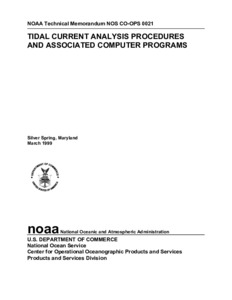| dc.contributor.author | Zervas, Chris | |
| dc.date.accessioned | 2019-01-07T19:20:05Z | |
| dc.date.available | 2019-01-07T19:20:05Z | |
| dc.date.issued | 1999 | |
| dc.identifier.citation | Zervas, C. (1999) Tidal current analysis procedures and associated computer programs. Silver Spring, MD, NOAA NOS Center for Operational Oceanographic Products and Services Products and Services, 103pp. (NOAA Technical Memorandum NOS CO-OPS, 021). DOI: http://dx.doi.org/10.25607/OBP-193 | en_US |
| dc.identifier.uri | http://hdl.handle.net/11329/634 | |
| dc.identifier.uri | http://dx.doi.org/10.25607/OBP-193 | |
| dc.description.abstract | The National Ocean Service (NOS) has been charged with producing tidal current tables for the
coastal areas of the United States. Tidal currents are almost always the strongest current
experienced by vessels operating offshore and for cons
iderable distances inside of bays and river
estuaries. Tidal currents are usually fastest where water level fluctuations on wide continental
shelfs are amplified as they approach the coast and water is forced through a narrow constricted
channel into a large bay or estuary.
Knowledge of the timing and strength of tidal currents is extremely important for safe navigation
in coastal waters. Mariners are primarily interested in the timing and strength of four phases of
the tidal current cycle which are printed in the NOS Tidal Current Tables. These phases are
slack before flood (SBF), maximum flood current (MFC), slack before ebb (SBE), and maximum
ebb current (MEC). Two other phases are also included in the NOS Tidal Current Tables. These
are minimum currents between two successive maximum currents in the same direction and are
known as slack flood current (SFC) and slack ebb current (SEC).
Although a standardized procedure has developed for analyzing water level data to obtain the
parameters required to produce the NOS Tide Tables, there has not been such a procedure
developed for tidal currents. This publication se
ts forth a suggested step-by-step procedure to
follow for obtaining the parameters needed to produce the NOS Tidal Current Tables. This is
followed by detailed explanations of each of the computer programs used. These sections are
designed to be stand-alone user’s guides for each of the programs, giving a complete explanation
of how the calculations are carried out, options to be set by the user, and sample input and output
files. Table A indicates the inputs and outputs for the major programs used in the analysis of
tidal currents. All the programs are written in FORTRAN. | en_US |
| dc.language.iso | en | en_US |
| dc.publisher | NOAA NOS Center For Operational Oceanographic Products and Services Products and Services | en_US |
| dc.relation.ispartofseries | NOAA Technical Memorandum NOS CO-OP;021 | |
| dc.rights | CC0 1.0 Universal | * |
| dc.rights.uri | http://creativecommons.org/publicdomain/zero/1.0/ | * |
| dc.subject.other | Tidal currents | en_US |
| dc.subject.other | Tidal prediction | en_US |
| dc.title | Tidal current analysis procedures and associated computer programs. | en_US |
| dc.type | Report | en_US |
| dc.description.status | Published | en_US |
| dc.format.pages | 103pp. | en_US |
| dc.description.refereed | Refereed | en_US |
| dc.publisher.place | Silver Spring, MD | en_US |
| dc.subject.parameterDiscipline | Parameter Discipline::Physical oceanography::Sea level | en_US |
| dc.rights.license | Public Domain | |
| dc.description.currentstatus | Current | en_US |
| dc.description.eov | Sea surface height | en_US |
| dc.description.bptype | Best Practice | en_US |
| dc.description.bptype | Guide | en_US |
| obps.contact.contactemail | coops.webmaster@noaa.gov | |
| obps.resourceurl.publisher | https://tidesandcurrents.noaa.gov/pub.html | en_US |
 Repository of community practices in Ocean Research, Applications and Data/Information Management
Repository of community practices in Ocean Research, Applications and Data/Information Management

